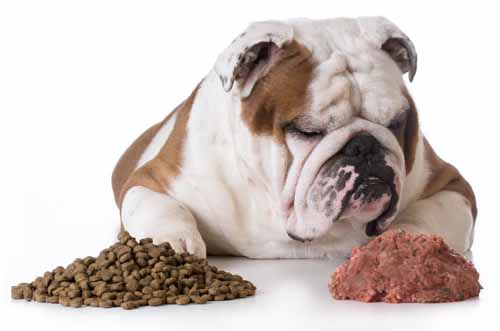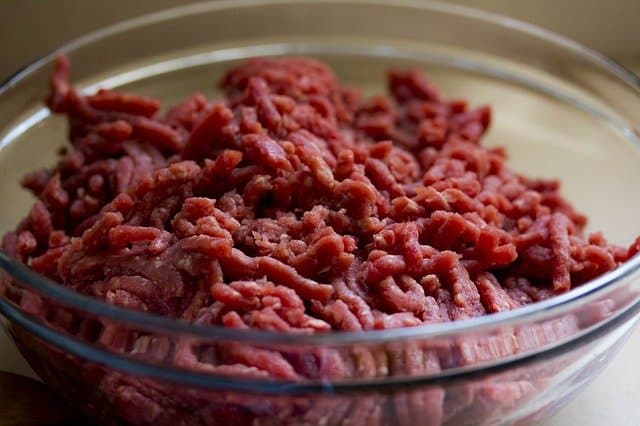Dogs love meat more than anything else.
Throughout the process of evolution, they have been eating a diet that primarily consists of meat.
Granted, they eat veggies and fruits but their diet is mostly made of meat.
With lots of protein and fats, meat will ensure that your doggie thrives.
Ground beef is inexpensive and flexible. It can be used to make a wide variety of things including tacos and burgers.
If you have puppies that are learning to eat or sick dogs, ground beef comes in very handy.
The challenge is knowing the right amount to offer your pooch. Too much and you risk triggering weight gain. Too little and your pup might end up with insufficient nutrients in her body.
We have put together a guide to help you know how much ground beef to feed your dog.
Benefits of Ground Beef to Dogs
Beef, whether ground, chopped, or in chunks, is a healthy food option for canines.
It is highly beneficial for the health of your pup for the following reasons.
I. High in Omega-3 Fatty Acids
Omega 3 fatty acids play a vital role in controlling brain function, skin integrity, cardiac health, and coat quality.
It promotes the development of the eyes and brain in puppies and improves brain function in older dogs.
The dog’s body doesn’t produce this all-important nutrient, no wonder commercial pet foods always have it as one of their ingredients.
II. Contains Vitamins and Antioxidants
No matter the age of your dog, he needs vitamins A and E.
The former ensures good health for the coat, muscle, and skin while the latter defends the canine’s body against oxidative stress.
Beef offers a sufficient amount of nutrients and keeps your dog healthy and happy.
III. Has a Wide Range of Minerals
Besides having omega 3- fatty acid, vitamins, and oxidants, beef is high in vital minerals such as iron, selenium, zinc, and vitamins B3 and B6.
Related Post: Plain Food Is No Longer Enough: 23 Vitamins and Minerals to Add To Your Homemade Dog Food.
How Much Should You Feed?

Ground meat can be used as part of your dog’s regular diet as long as you know how much to offer.
Essentially, you want to make sure the meat is lean and unseasoned, as much as possible.
According to Founders Veterinary Clinic, a dog needs 0.25-0.3 pounds of meat per day for 20 pounds of body weight.
This goes for all types of meat including ground beef, shredded chicken, lean beef steak, skinless turkey, lamb, rabbit, and all types of fish.
Based on this, small breeds of under 30 pounds need less than 0.33 lbs of meat while medium breeds of 30-50 pounds need anywhere from 0.35-0.5 lbs per day.
Large breeds of over 100 pounds need over 1.25 pounds of ground meat daily.
This sounds insufficient but meat is very nutritionally dense. A little always goes a long way.
In case you are mixing ground beef with other food options, you need to calculate how much food the dog needs per day and subtract the meat allotment.
On average, dogs need 2-3% of food per body weight daily.
Let’s use the example of a 60-pound Border collie. Her daily food allotment is 2% of 60 pounds which is 1.2 pounds.
Ground meat is 0.25 pounds x 3 which is 0.75 pounds. That means the rest of the food should be 1.2-0.75 which is 0.45 pounds.
Cooked or Raw?
The debate whether to feed raw or cooked meat has been going for a very long time.
The truth of the matter is that dogs have existed on a raw food diet for centuries pretty fine.
Back then, there were no humans to cook for them. They would go to the wild, spot a deer or something, chase it down, kill it, and begin eating right there.
Not only is raw food convenient for pet owners but it also delivers amazing benefits for the canine. These include improved dental health, healthier skin, increased energy, a shinier coat, and smaller stools.
On the flip side, raw meat contains some of the deadliest bacteria including Salmonella spp., Yersinia, and E.coli among others.
The reason is that meat is highly nutritious and has a water activity of approximately 0.99. These nasty microorganisms thrive in such conditions.
In addition to naturally occurring bacteria, meat is also contaminated with other microorganisms during the slaughtering processes.
If the personnel and tools used during the preparation process are of low hygiene standards, it will reflect on the result.
Having said that, dogs have been designed to handle bacteria found in raw meat.
For one, they always pass stool right after eating. This prevents bacteria buildup in the colon.
Secondly, the canine digestive system is rather short to push food and bacteria fast hence inhibiting the colonization of bacteria.
Finally, dogs have acidic stomachs that further prevent bacteria from colonizing in the gut.
In the end, the choice of feeding your pup cooked or raw meat depends on you. As long it is lean and sourced from grass-fed cattle, you should be fine.
Related Posts:
How to prepare marrow bones for dogs
The Best Smoked Bones for Dogs
7 Best Store-Bought Bone Broth for Dogs (plus Easy Homemade Recipes)
More Tips for Helping Your Pup Get the Most Out Of Ground Beef

A. Choose lean beef over fatty beef
Use meat: fat ratio of 90:10 when choosing ground beef for your dog.
The canine system handles lean meat better than fat.
If the fat percentage goes overboard, it might trigger pancreatitis in your dog.
Anyone that has dealt with this fatal condition before known better than to mess with it.
Related Post: What to Feed a Dog with Pancreatitis
B. Supplement Ground Beef
While meat has essential nutrients, it is also lacking in some including calcium.
This specific mineral is an electrolyte whose function is to regulate the concentration of fluids in the cells.
It also transmits important signals, conducts impulses, contracts muscles, and sends/receives transmitters.
Find calcium and phosphorous sources and include them in the dog’s diet.
C. Only Boil or Sauté the Ground Beef
If you decide to cook your meat, the best option is to boil it in a pan with boiling water.
After the contents are boiling, simmer until the meat turns from pink to brown.
Drain off the fat and cool the meat before giving it to the dog.
To make it tastier, you can sauté the beef alongside veggies such as grated carrot, chopped zucchini, and fresh parsley.
Final Thoughts
Knowing how much food to feed your dog has a very direct link to his overall health.
Although he likes ground beef, you should never go more than ¼-1/3 pounds for every 20 pounds per day.
The rest is for things like carbohydrates, vegetables, non-meat proteins, and supplements (if any).
Other Posts Related To How Much Food To Feed Your Dog:
How Much Canned Food Should You Feed a Dog Per Day?
How Much Rice Should You Feed A Dog With Diarrhea?
How Much Peanut Butter Can A Dog Have?
How Much Yogurt Should You Give a Dog With Diarrhea?
How Much Pumpkin Should You Give a Dog For Constipation?
As an Amazon Associate, we may receive a small commission from qualifying purchases but at no extra cost to you. Learn more. Amazon and the Amazon logo are trademarks of Amazon.com, Inc, or its affiliates.

